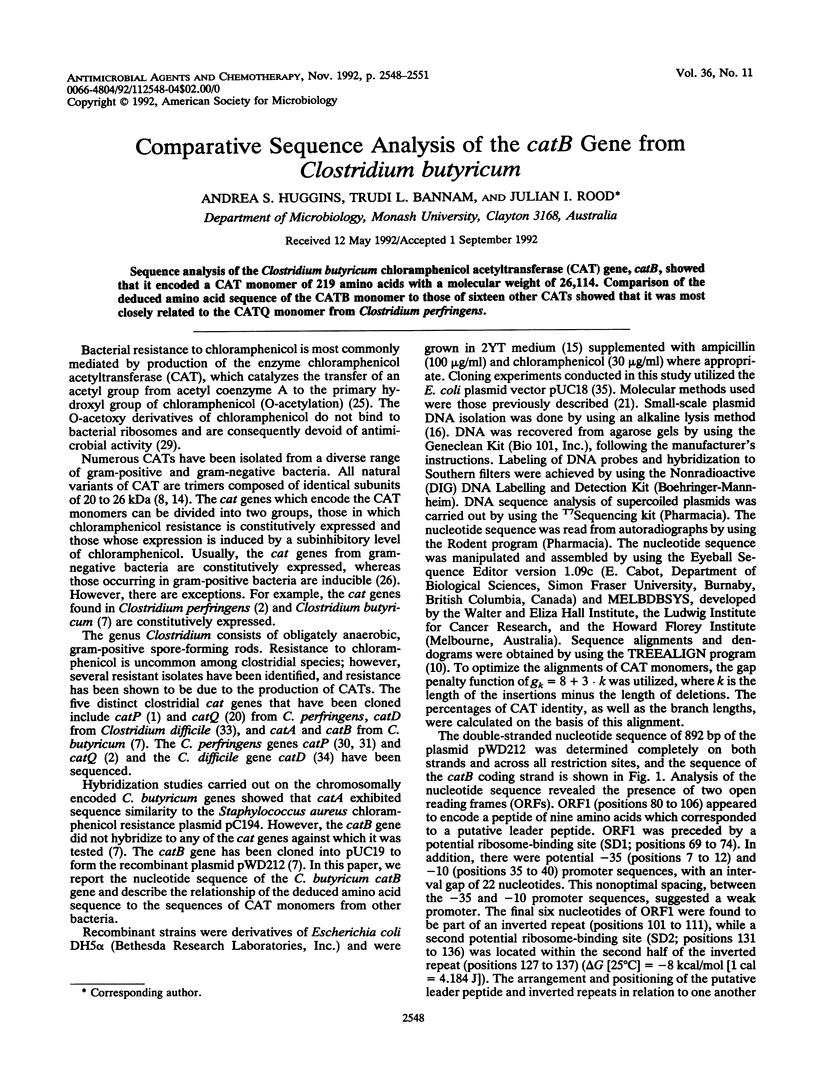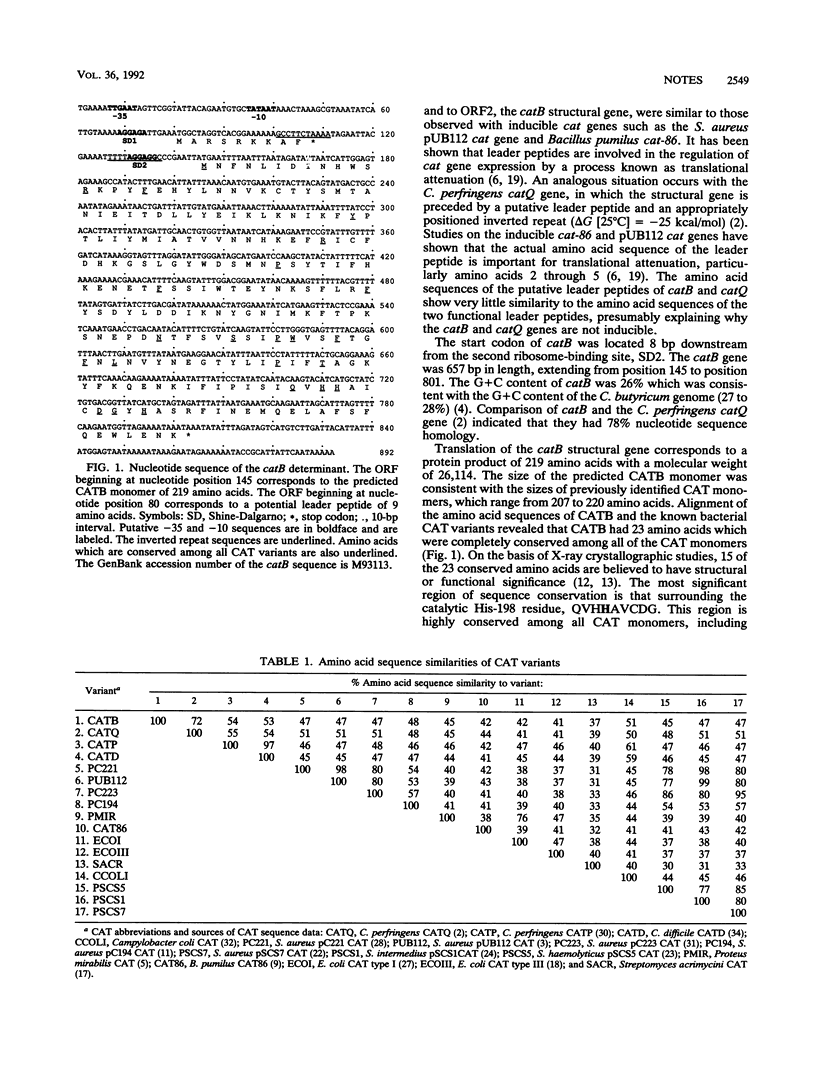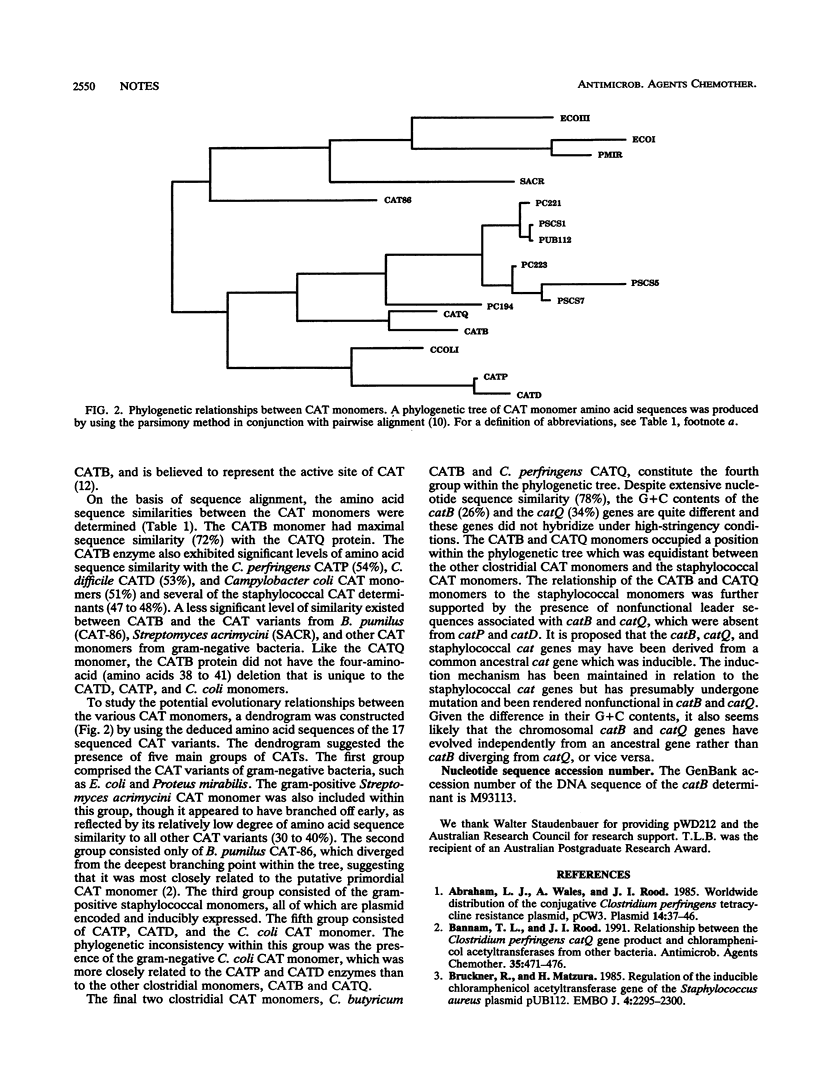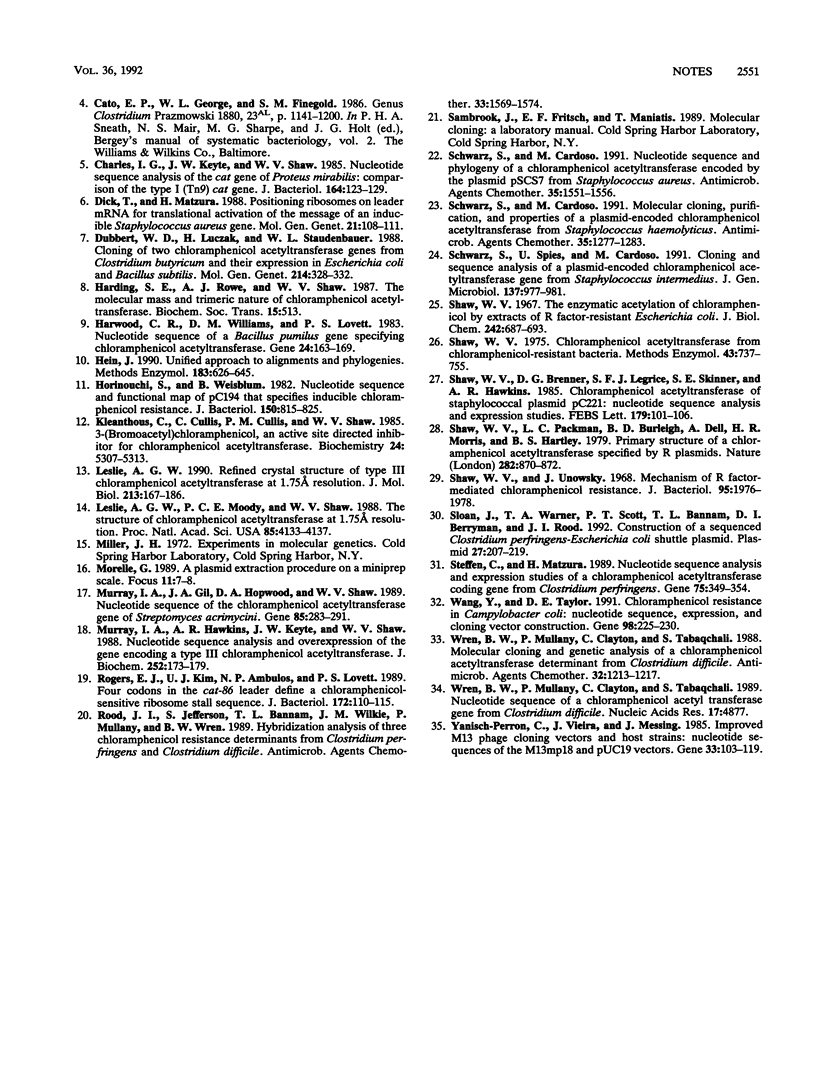Abstract
Sequence analysis of the Clostridium butyricum chloramphenicol acetyltransferase (CAT) gene, catB, showed that it encoded a CAT monomer of 219 amino acids with a molecular weight of 26,114. Comparison of the deduced amino acid sequence of the CATB monomer to those of sixteen other CATs showed that it was most closely related to the CATQ monomer from Clostridium perfringens.
Full text
PDF



Selected References
These references are in PubMed. This may not be the complete list of references from this article.
- Bannam T. L., Rood J. I. Relationship between the Clostridium perfringens catQ gene product and chloramphenicol acetyltransferases from other bacteria. Antimicrob Agents Chemother. 1991 Mar;35(3):471–476. doi: 10.1128/aac.35.3.471. [DOI] [PMC free article] [PubMed] [Google Scholar]
- Brückner R., Matzura H. Regulation of the inducible chloramphenicol acetyltransferase gene of the Staphylococcus aureus plasmid pUB112. EMBO J. 1985 Sep;4(9):2295–2300. doi: 10.1002/j.1460-2075.1985.tb03929.x. [DOI] [PMC free article] [PubMed] [Google Scholar]
- Charles I. G., Keyte J. W., Shaw W. V. Nucleotide sequence analysis of the cat gene of Proteus mirabilis: comparison with the type I (Tn9) cat gene. J Bacteriol. 1985 Oct;164(1):123–129. doi: 10.1128/jb.164.1.123-129.1985. [DOI] [PMC free article] [PubMed] [Google Scholar]
- Dick T., Matzura H. Positioning ribosomes on leader mRNA for translational activation of the message of an inducible Staphylococcus aureus cat gene. Mol Gen Genet. 1988 Sep;214(1):108–111. doi: 10.1007/BF00340187. [DOI] [PubMed] [Google Scholar]
- Dubbert W., Luczak H., Staudenbauer W. L. Cloning of two chloramphenicol acetyltransferase genes from Clostridium butyricum and their expression in Escherichia coli and Bacillus subtilis. Mol Gen Genet. 1988 Oct;214(2):328–332. doi: 10.1007/BF00337731. [DOI] [PubMed] [Google Scholar]
- Harwood C. R., Williams D. M., Lovett P. S. Nucleotide sequence of a Bacillus pumilus gene specifying chloramphenicol acetyltransferase. Gene. 1983 Oct;24(2-3):163–169. doi: 10.1016/0378-1119(83)90076-8. [DOI] [PubMed] [Google Scholar]
- Hein J. Unified approach to alignment and phylogenies. Methods Enzymol. 1990;183:626–645. doi: 10.1016/0076-6879(90)83041-7. [DOI] [PubMed] [Google Scholar]
- Horinouchi S., Weisblum B. Nucleotide sequence and functional map of pC194, a plasmid that specifies inducible chloramphenicol resistance. J Bacteriol. 1982 May;150(2):815–825. doi: 10.1128/jb.150.2.815-825.1982. [DOI] [PMC free article] [PubMed] [Google Scholar]
- Kleanthous C., Cullis P. M., Shaw W. V. 3-(Bromoacetyl)chloramphenicol, an active site directed inhibitor for chloramphenicol acetyltransferase. Biochemistry. 1985 Sep 24;24(20):5307–5313. doi: 10.1021/bi00341a006. [DOI] [PubMed] [Google Scholar]
- Leslie A. G., Moody P. C., Shaw W. V. Structure of chloramphenicol acetyltransferase at 1.75-A resolution. Proc Natl Acad Sci U S A. 1988 Jun;85(12):4133–4137. doi: 10.1073/pnas.85.12.4133. [DOI] [PMC free article] [PubMed] [Google Scholar]
- Leslie A. G. Refined crystal structure of type III chloramphenicol acetyltransferase at 1.75 A resolution. J Mol Biol. 1990 May 5;213(1):167–186. doi: 10.1016/S0022-2836(05)80129-9. [DOI] [PubMed] [Google Scholar]
- Murray I. A., Gil J. A., Hopwood D. A., Shaw W. V. Nucleotide sequence of the chloramphenicol acetyltransferase gene of Streptomyces acrimycini. Gene. 1989 Dec 28;85(2):283–291. doi: 10.1016/0378-1119(89)90420-4. [DOI] [PubMed] [Google Scholar]
- Murray I. A., Hawkins A. R., Keyte J. W., Shaw W. V. Nucleotide sequence analysis and overexpression of the gene encoding a type III chloramphenicol acetyltransferase. Biochem J. 1988 May 15;252(1):173–179. doi: 10.1042/bj2520173. [DOI] [PMC free article] [PubMed] [Google Scholar]
- Rogers E. J., Kim U. J., Ambulos N. P., Jr, Lovett P. S. Four codons in the cat-86 leader define a chloramphenicol-sensitive ribosome stall sequence. J Bacteriol. 1990 Jan;172(1):110–115. doi: 10.1128/jb.172.1.110-115.1990. [DOI] [PMC free article] [PubMed] [Google Scholar]
- Rood J. I., Jefferson S., Bannam T. L., Wilkie J. M., Mullany P., Wren B. W. Hybridization analysis of three chloramphenicol resistance determinants from Clostridium perfringens and Clostridium difficile. Antimicrob Agents Chemother. 1989 Sep;33(9):1569–1574. doi: 10.1128/aac.33.9.1569. [DOI] [PMC free article] [PubMed] [Google Scholar]
- Schilling J., Wang Y., Lau K., Smith L., Cordell B. Synthesis and characterization of the Kunitz protease-inhibitor domain of the beta-amyloid precursor protein. Gene. 1991 Feb 15;98(2):225–230. doi: 10.1016/0378-1119(91)90177-d. [DOI] [PubMed] [Google Scholar]
- Schwarz S., Cardoso M. Molecular cloning, purification, and properties of a plasmid-encoded chloramphenicol acetyltransferase from Staphylococcus haemolyticus. Antimicrob Agents Chemother. 1991 Jul;35(7):1277–1283. doi: 10.1128/aac.35.7.1277. [DOI] [PMC free article] [PubMed] [Google Scholar]
- Schwarz S., Cardoso M. Nucleotide sequence and phylogeny of a chloramphenicol acetyltransferase encoded by the plasmid pSCS7 from Staphylococcus aureus. Antimicrob Agents Chemother. 1991 Aug;35(8):1551–1556. doi: 10.1128/aac.35.8.1551. [DOI] [PMC free article] [PubMed] [Google Scholar]
- Schwarz S., Spies U., Cardoso M. Cloning and sequence analysis of a plasmid-encoded chloramphenicol acetyltransferase gene from Staphylococcus intermedius. J Gen Microbiol. 1991 Apr;137(4):977–981. doi: 10.1099/00221287-137-4-977. [DOI] [PubMed] [Google Scholar]
- Shaw W. V., Brenner D. G., LeGrice S. F., Skinner S. E., Hawkins A. R. Chloramphenicol acetyltransferase gene of staphylococcal plasmid pC221. Nucleotide sequence analysis and expression studies. FEBS Lett. 1985 Jan 1;179(1):101–106. doi: 10.1016/0014-5793(85)80200-3. [DOI] [PubMed] [Google Scholar]
- Shaw W. V. Chloramphenicol acetyltransferase from chloramphenicol-resistant bacteria. Methods Enzymol. 1975;43:737–755. doi: 10.1016/0076-6879(75)43141-x. [DOI] [PubMed] [Google Scholar]
- Shaw W. V., Packman L. C., Burleigh B. D., Dell A., Morris H. R., Hartley B. S. Primary structure of a chloramphenicol acetyltransferase specified by R plasmids. Nature. 1979 Dec 20;282(5741):870–872. doi: 10.1038/282870a0. [DOI] [PubMed] [Google Scholar]
- Shaw W. V. The enzymatic acetylation of chloramphenicol by extracts of R factor-resistant Escherichia coli. J Biol Chem. 1967 Feb 25;242(4):687–693. [PubMed] [Google Scholar]
- Shaw W. V., Unowsky J. Mechanism of R factor-mediated chloramphenicol resistance. J Bacteriol. 1968 May;95(5):1976–1978. doi: 10.1128/jb.95.5.1976-1978.1968. [DOI] [PMC free article] [PubMed] [Google Scholar]
- Sloan J., Warner T. A., Scott P. T., Bannam T. L., Berryman D. I., Rood J. I. Construction of a sequenced Clostridium perfringens-Escherichia coli shuttle plasmid. Plasmid. 1992 May;27(3):207–219. doi: 10.1016/0147-619x(92)90023-4. [DOI] [PubMed] [Google Scholar]
- Steffen C., Matzura H. Nucleotide sequence analysis and expression studies of a chloramphenicol-acetyltransferase-coding gene from Clostridium perfringens. Gene. 1989 Feb 20;75(2):349–354. doi: 10.1016/0378-1119(89)90282-5. [DOI] [PubMed] [Google Scholar]
- Wren B. W., Mullany P., Clayton C., Tabaqchali S. Molecular cloning and genetic analysis of a chloramphenicol acetyltransferase determinant from Clostridium difficile. Antimicrob Agents Chemother. 1988 Aug;32(8):1213–1217. doi: 10.1128/aac.32.8.1213. [DOI] [PMC free article] [PubMed] [Google Scholar]
- Wren B. W., Mullany P., Clayton C., Tabaqchali S. Nucleotide sequence of a chloramphenicol acetyl transferase gene from Clostridium difficile. Nucleic Acids Res. 1989 Jun 26;17(12):4877–4877. doi: 10.1093/nar/17.12.4877. [DOI] [PMC free article] [PubMed] [Google Scholar]
- Yanisch-Perron C., Vieira J., Messing J. Improved M13 phage cloning vectors and host strains: nucleotide sequences of the M13mp18 and pUC19 vectors. Gene. 1985;33(1):103–119. doi: 10.1016/0378-1119(85)90120-9. [DOI] [PubMed] [Google Scholar]


